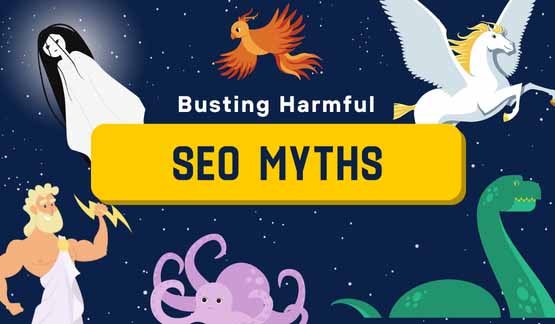Introduction: Time to Bust Some Harmful SEO Myths
If you’ve ever wondered why your website isn’t bringing in leads—or why your competitors keep showing up in search results while you’re left out—chances are outdated or incorrect SEO beliefs are holding you back.
SEO is one of the most powerful tools for service businesses like contractors, business consultants, and specialized healthcare providers. But if you’re following the wrong advice, you could be wasting time, money, and opportunities.
Let’s bust five of the most common SEO myths and show you what actually works.
Myth #1: SEO Is All About Keywords
Why People Believe This
Back in the early days of SEO, stuffing your website with keywords—often in unnatural ways—could boost rankings. Some business owners still think their website needs to say “best plumber in [city]” on every page to rank.
Why It’s Wrong
- Search Intent Matters More Than Keywords – Google prioritizes content that actually helps users, not just keyword-heavy pages.
- User Experience Signals Matter – If visitors leave your page quickly because it’s unreadable, Google sees that as a negative ranking factor.
- Keyword Stuffing Can Backfire – Overusing keywords can make your site look spammy and even result in penalties.
What to Do Instead
- Focus on Search Intent – Answer customer questions with valuable, well-structured content.
- Use Keywords Naturally – Sprinkle variations throughout your content, but don’t force them.
- Prioritize Readability – Write for humans first, Google second.
Example: Instead of stuffing “roof repair” into every sentence, write a blog post titled “How to Know If You Need Roof Repairs: 5 Signs to Watch For.” This keeps the content natural while still optimizing for search.
Myth #2: “My Website Was Optimized When It Was Built, So My SEO Is Done”
Why People Believe This
Your website was designed with SEO-friendly pages, optimized with a tool like Yoast, and submitted to Google. Your web designer told you it was “SEO optimized,” so you assumed it was complete.
Why It’s Wrong
- SEO at Launch ≠ Ongoing SEO – A five-page site with basic optimizations is a starting point, not a strategy.
- No Fresh Content = No Growth – Websites that don’t regularly update with new content (blogs, case studies, FAQs) lose rankings over time.
- No Backlinks, No Authority – If no other websites link to yours, Google doesn’t see it as trustworthy.
What to Do Instead
- Publish Fresh Content Regularly – Blog posts, service updates, and FAQs keep your site active and relevant.
- Earn Backlinks from Trusted Sources – Get listed in directories, mentioned by local businesses, and linked in industry articles.
- Track & Adapt – Use Google Search Console to see how your rankings change and adjust your strategy accordingly.
Bottom Line: A website that was optimized at launch is like a car that was fueled when you bought it—without maintenance and refueling, it’s not going anywhere.
Myth #3: More Traffic = More Customers
Why People Believe This
It seems logical: if more people visit your site, more of them should become customers, right?
Why It’s Wrong
- Not All Traffic Is Good Traffic – Ranking for “HVAC tips” might bring in visitors from across the country—but if you only serve one city, they won’t convert.
- High Bounce Rates Can Hurt Rankings – If people visit your site but quickly leave, it tells Google your page wasn’t helpful.
- Local Intent Matters – A visitor from three states away won’t help your business, but a visitor searching for “emergency AC repair near me” will.
What to Do Instead
- Focus on High-Intent Keywords – Target searches that indicate someone is ready to hire, like “roofing company near me” or “best tax accountant in [city].”
- Make Converting Easy – Ensure your site has clear calls to action (CTAs), like click-to-call buttons and quote request forms.
- Track Quality, Not Just Quantity – Monitor leads and conversions instead of just traffic numbers.
Myth #4: It’s Too Competitive to Rank in Search
Why People Believe This
Big brands and national franchises dominate Google search results, making it seem impossible for small businesses to compete.
Why It’s Wrong
- Google Prioritizes Relevance Over Size – If your site is highly relevant for a specific local or niche search, you can outrank bigger companies.
- Long-Tail Keywords Are Easier to Rank For – Instead of competing for “roofing company,” you can rank for “metal roof installation in [city].”
- Local SEO Is a Game-Changer – Google wants to show local businesses when users search for services in their area.
What to Do Instead
- Go Hyper-Local – Optimize for your city, neighborhood, and service area.
- Target Long-Tail Keywords – Focus on highly specific, lower-competition searches that your ideal customers actually use.
- Leverage Local Listings & Reviews – Google Business Profile, Yelp, Angi, and industry directories boost local credibility.
Myth #5: A Single Listing Is Enough—And Reviews Don’t Really Matter
Why People Believe This
Many businesses assume that once they set up their Google Business Profile, their job is done. Others think reviews are just for reputation, not for SEO.
Why It’s Wrong
- Google Cross-Checks Your Business Information – If your Name, Address, and Phone Number (NAP) are inconsistent across Yelp, Angi, and Facebook, Google sees conflicting data and ranks you lower.
- Reviews Affect Rankings – Google considers review quantity, frequency, and sentiment when deciding search rankings.
- User Trust Matters – Most customers read reviews before making a decision. If you’re not actively managing your reviews, you’re losing business.
What to Do Instead
- Ensure Consistency Across Directories – Use a tool like Moz Local or BrightLocal to monitor your business listings.
- Encourage & Respond to Reviews – More positive, recent reviews = higher rankings and more conversions.
- Update Your Listings Regularly – Post photos, answer customer Q&A, and keep your details up to date.
Final Thoughts: Stop Falling for These 5 SEO Myths
SEO isn’t a quick fix—it’s a long-term strategy.
Here’s what you need to remember:
✅ SEO isn’t just about keywords—user experience and search intent matter more.
✅ A website optimized at launch still needs continuous updates and maintenance.
✅ More traffic doesn’t mean more customers—targeted, high-intent visitors do.
✅ You can compete with bigger brands using local SEO and niche targeting.
✅ Consistent listings and strong reviews boost rankings and trust.
By avoiding these SEO myths, your service business can build a strong, sustainable online presence that attracts the right customers. SEO isn’t about outdated tactics or shortcuts—it’s about providing value, optimizing for search intent, and staying consistent with best practices. Whether it’s keeping your website updated, leveraging local SEO, or focusing on quality over quantity, debunking these misconceptions will set you up for long-term success. Don’t SEO myths hold you back—take action today and start seeing real results in your search rankings!



